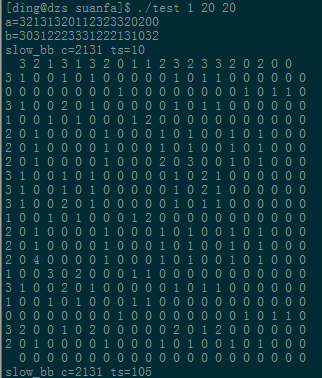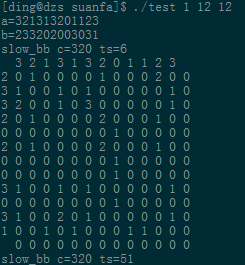/************************************************************************* > File Name: lcs.c > Author: dingzhengsheng > Mail: [email protected] > Created Time: 2015年05月20日 星期三 16時07分50秒 > Version: v0.01 > Description: > History: ************************************************************************/ #include<stdio.h> #include<time.h> #include<stdlib.h> #include <unistd.h> #include<string.h> #include<sys/time.h> #include<ctype.h> #include"test_time.h"
#define DEBUG 1 void slow_bb(char *a,int lena,char *b,int lenb, char *c) { int i; int j; int index; int max=0; int num=0; int start; for(i=0; i<lena; i++) { for(j=0; j<lenb; j++) { int start1 = i; int start2 = j; while((start1 < lena-1) && (start2<lenb-1) && (a[start1++] == b[start2++])) num++; if(num > max) { max = num; start = i; } num = 0; } } strncpy(c, a+start, max); } void lcs(char *a, int lena, char *b, int lenb, char *c) { int i; int j; int s[lena+1]; memset(s, 0, sizeof(int)*(lena+1)); int maxlen = 0; int pos; #ifdef DEBUG int *dbg; dbg= (int *)malloc(sizeof(int)*(lenb+1)*(lena+1)); memset(dbg, 0, sizeof(int)*(lenb+1)*(lena+1)); #endif for(j=lenb-1; j>=0; j--) { for(i=0; i<lena; i++) { if(b[j] == a[i]) { #ifdef DEBUG *(dbg+j*(lena+1)+i) = s[i] = s[i+1]+1; #else s[i] = s[i+1]+1; #endif if(s[i] > maxlen) { maxlen = s[i] ; pos = i; } } else { /* if(s[i+1] > maxlen) { maxlen = s[i+1]; pos = i+1; } */ s[i] = 0; } } } #ifdef DEBUG for(i=0; i<lenb+1; i++) { if(i == 0) { printf(" "); for(j=0; j<lena; j++) printf("%c ", a[j]); printf("\n"); } if(i == lenb) printf(" "); for(j=0; j<lena+1; j++) { if(j == 0) printf("%c ", b[i]); printf("%d ", *(dbg+i*(lena+1)+j)); } printf("\n"); } #endif strncpy(c,&a[pos], maxlen); } void main(int argc, char *argv[]) { char *a; char *b; int a_len; int b_len; char *c; int n = 100; int i=0; if(argc >= 1) n = atoi(argv[1]); if(argc >= 3) { a_len = atoi(argv[2]); b_len = atoi(argv[3]); } a = malloc(a_len); b = malloc(b_len); c = malloc(a_len); for(i=0; i<a_len; i++) a[i] =random()%4 + 0x30; for(i=0; i<b_len; i++) b[i] =random()%4 + 0x30; printf("a=%s\n", a); printf("b=%s\n", b); memset(c, 0, sizeof(c)); starts(); for(i=0;i<n;i++) slow_bb(a, a_len, b, b_len, c); ends(); printf("slow_bb c=%s ts=%lld\n", c, tt()); memset(c, 0, sizeof(c)); starts(); for(i=0;i<n;i++) lcs(a, a_len, b, b_len, c); ends(); printf("slow_bb c=%s ts=%lld\n", c, tt()); free(a); free(b); free(c); }
test_time.c:
#include<stdio.h>
#include<time.h>
#include <unistd.h>
#include<string.h>
#include<sys/time.h>
#include<sys/resource.h>
#include"test_time.h"
#define SECTOUSEC 1000000
static struct timeval tv1,tv2;
void starts()
{
gettimeofday(&tv1,NULL);
}
void ends()
{
gettimeofday(&tv2,NULL);
}
long int get_diff_time(struct timeval *tv1, struct timeval *tv2)
{
long int n;
n = (tv2->tv_sec - tv1->tv_sec)*SECTOUSEC + tv2->tv_usec - tv1->tv_usec;
return n;
}
long int tt()
{
return get_diff_time(&tv1, &tv2);
}
test_time.h:
/*************************************************************************
> File Name: test_time.h
> Author: dingzhengsheng
> Mail: [email protected]
> Created Time: 2015年05月20日 星期三 20時02分00秒
> Version: v0.01
> Description:
> History:
************************************************************************/
#ifndef __TEST_TIME_H
#define __TEST_TIME_H
void starts();
void ends();
long int tt();
#endif
運行結果:(矩陣的打印受宏DEBUG控制),後者耗時更長就是因為打印矩陣




注:代碼中沒有對最長子串有多個的情況做處理,兩個函數的結果可能會不一樣,可以用數組記錄多個相同長度最長子串